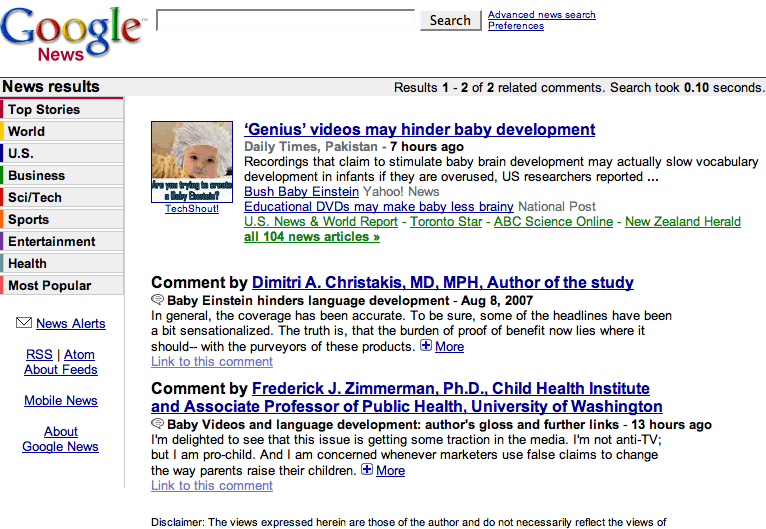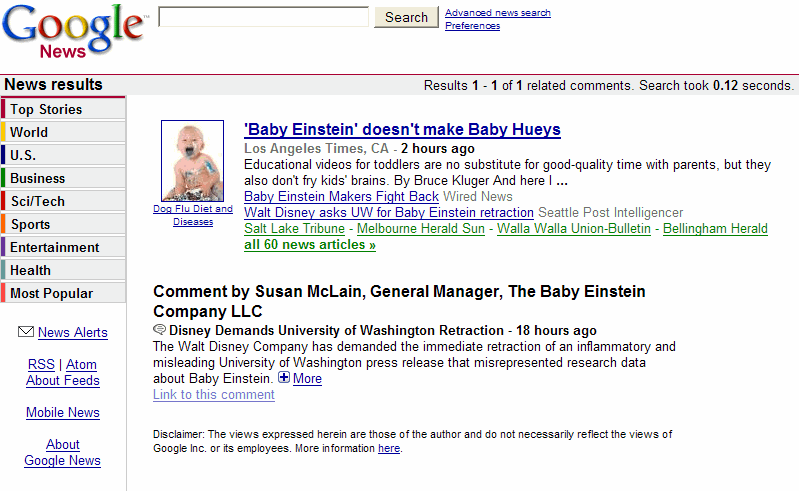August 11, 2007
Baby videos and Google News comments
A few days ago, an interesting paper came out: F. J. Zimmerman, D.A. Christakis, and A.N. Meltzoff, "Associations between Media Viewing and Language Development in Children under Age 2 Years", The Journal of Pediatrics, article in press, available online 7 August 2007. The study design:
A total of 1008 parents of children age 2 to 24 months, identified by birth certificates, were surveyed by telephone in February 2006. Questions were asked about child and parent demographics, child-parent interactions, and child's viewing of several content types of television and DVDs/videos. Parents were also asked to complete the short form of the MacArthur-Bates Communicative Development Inventory (CDI). The associations between normed CDI scores and media exposure were evaluated using multivariate regression, controlling for parent and child demographics and parent–child interactions.
And the results?
Among infants (age 8 to 16 months), each hour per day of viewing baby DVDs/videos was associated with a 16.99-point decrement in CDI score in a fully adjusted model (95% confidence interval = −26.20 to −7.77). Among toddlers (age 17 to 24 months), there were no significant associations between any type of media exposure and CDI scores. Amount of parental viewing with the child was not significantly associated with CDI scores in either infants or toddlers.
If you've been reading Language Log recently, you might think that I'm going to complain about how this paper was described in the mainstream media. But I'm not -- the coverage was a bit sensationalized, unsurprisingly, but not especially problematic. Instead, I want to point to two interesting and basically good things, one from a big-time new-media source and the other from the paper itself.
Also on August 7, Google News rolled out "Perspectives about the news from people in the news".
We'll be trying out a mechanism for publishing comments from a special subset of readers: those people or organizations who were actual participants in the story in question. Our long-term vision is that any participant will be able to send in their comments, and we'll show them next to the articles about the story. Comments will be published in full, without any edits, but marked as "comments" so readers know it's the individual's perspective, rather than part of a journalist's report.
[...] [W]e're hoping that by adding this feature, we can help enhance the news experience for readers, testing the hypothesis that -- whether they're penguin researchers or presidential candidates-- a personal view can sometimes add a whole new dimension to the story.
In the case of the baby-video study, there are comments by two of the three authors, Frederick J. Zimmerman and Dimitri A. Christakis.
Given how much I've complained about misleading science journalism, it's easy for me to see the upside. At least, researchers will have an enhanced opportunity to reach the public with their own perspective on work that makes it into the popular press.
But there's an interesting and important set of editorial problems here. How will the folks at Google News decide who is one of the "actual participants in the story in question"? There are some people who obviously are in that set, and some who obviously are not, but there's a grey area, where some arbiter will have to decide who's in and who's out. Who will that arbiter be? What criteria will be used? And what sort of accountability or appeal will there be?
And how, on the notoriously fraud-prone internet, will Google's comments editors verify that Dr. Martha D. Penguin-Researcher <penguin.researcher123@gmail.com> is who she says she is? I wonder when we'll see the first hoax.
I also want to mention a couple of good things about the Zimmerman et al. study.
First, they focus on the magnitude of the negative effect of "baby videos", not just on the question of whether the effect was "statistically significant". And they express the effect's magnitude in three ways -- (1) as regression results, where the regression coefficients are denominated in intuitively meaningful units, namely percentile increases or decreases in normed CDI scores; (2) as a comparison of the effects of various interventions, including positive ones like reading or telling stories to the children at least once a day; (3) as a translation of the normed-CDI-score effects into more concrete terms, namely the expected difference in vocabulary size.
Second, they present a clear and sensible discussion of what their results might mean, including an explicit discussion of several alternative interpretations other than (their preferred) conclusion that baby videos harm infant language development. It's surprisingly rare to see this kind of frank and honest appraisal of alternative explanations.
(For an example of a published study whose presentation is, well, different from this, see here.)
Here's the table of regression results from Zimmerman et al., followed by part of their discussion:
| Age 8 to 16 months | Age 17 to 24 months |
|||
|---|---|---|---|---|
| Variable | Coefficient | [95% CI] | Coefficient | [95% CI] |
| Parental interactions | ||||
| Reading at least once daily | 7.07 |
[0.53,13.60] | 11.72 |
[1.86,21.59] |
| Storytelling at least once daily | 6.47 |
[0.23,12.71] | 7.13† | [−0.11,14.37] |
| Music listening at least several times weekly | 5.36 | [−1.92,12.64] | 7.2 | [−2.10,16.50] |
| Children's media watching time (hours/day) | ||||
| Baby DVDs/videos | −16.99  |
[−26.20,−7.77] | 3.66 | [−4.45,11.77] |
| Children's educational shows | 1.72 | [−4.42,7.87] | 2.21 | [−1.74,6.15] |
| Movies and children's noneducational TV | 6.6 | [−1.81,15.02] | 2.03 | [−2.78,6.83] |
| Grownup TV | −1.42 | [−11.57,8.73] | 2.38 | [−5.68,10.45] |
| Parental viewing with child | ||||
| Rarely or about half the time (referent) | ||||
| Usually or always | 5.57 | [−2.10,13.23] | 0.39 | [−6.74,7.52] |
| N/A: no media viewing | −7.70† | [−15.49,0.08] | 2.65 | [−7.29,12.60] |
| r2 | 0.17 | 0.18 | ||
| n | 384 | 345 | ||
This analysis reveals a large negative association between viewing of baby DVDs/videos and vocabulary acquisition in children age 8 to 16 months. The 17-point difference associated in the analysis with each hour of baby DVD/video watching corresponds to a difference of about 6 to 8 words for a typical child out of the 90 included on the CDI. There are 3 possible reasons for this association. First, because many baby DVDs/videos are heavily advertised as promoting cognitive, language, and brain development, it is possible that parents who are concerned about their child's language development turn to baby videos for help. If this is indeed the case, then it would be fair to say that the poor language development causes greater viewing of baby DVDs/videos.
A second possible explanation for the association between baby DVD/video viewing and vocabulary is that of residual confounding; that is, other variables (not measured in our data) could lead to both high baby DVD/video watching and slow language development. One possible example to illustrate this would arise if those parents who have their children watch a heavy dose of baby DVDs/videos are those who are less motivated to actively promote their children's language development. We partially controlled for this possibility with the parent-interaction variables, but we cannot capture the quality of these interactions, which surely varies. A second possible source of residual confounding would exist if parents who are inattentive, distracted, or simply pressed for time are more likely to rely on baby DVDs/videos as a babysitter. Such parents also might be less likely to know how many words their children know. Although we attempted to adjust for many social and demographic factors that might confound the observed association, it is possible that this adjustment was incomplete.
Finally, it is possible that heavy viewing of baby DVDs/videos has a deleterious effect on early language development. The first 3 years of life are characterized by rapid brain development, and environmental factors are known to influence how the brain develops. It is plausible that extensive exposure to an absorbing but not developmentally constructive stimulus could affect brain development and language acquisition. Heavy viewing of baby DVDs/videos may constitute such an environmental influence. If so, there are several potential causal mechanisms through which such an effect might occur. The viewing of baby DVDs/videos might crowd out interaction time with adult caregivers in ways not measured here. For example, we did not measure the time parents spend directly talking to their infants, or the nature and quality of this verbal input, which are known to be important factors in early language development. Baby DVDs/videos contain limited language and display a certain combination of formal features (short scenes and flashy screen images), which might not promote vocabulary learning or might lead to habits of mind that actually impede it. Whether these formal features are systematically different than those of the other content types represented here has not been formally studied.
Here's a screenshot of what the Google News "comments" page for the Zimmerman et al. story looks like this morning, since I have no idea how long this story and its associated comments will remain accessible:

[Update -- Disney defends Baby Einstein against the UW press release, and demands a retraction. Disney makes some good points -- the UW press release begins
Despite marketing claims, parents who want to give their infants a boost in learning language probably should limit the amount of time they expose their children to DVD's and videos such as 'Baby Einstein' and 'Brainy Baby'. Rather than helping babies, the over-use of such productions actually may slow down infants eight to 16 months of age when it comes to acquiring vocabulary, according to a new study by researchers at the University of Washington and Seattle Children's Hospital Research Institute.
although the study didn't actually examine the effect of baby videos in an experimental setting, being based only on answers to a survey that didn't ask about any products in particular, and carefully avoids making causal claims. The study didn't deal with anyone's marketing claims at all. One point that Disney fails to make is that all the survey results put together accounted for only 17% of the variance in CDI scores.
However, it would be a lot easier to feel sympathetic to Disney if they had themselves done any experimental validation of their marketing claims about the product that they sell, and in particular any experiments to verify that the product doesn't actually do harm. (I conclude that no such experiments have been done from the fact that the flack doesn't cite them.)
Anyhow, the Google News comments from the study's authors are gone, replaced by a stern note from Baby Einstein's general manager:

]
Posted by Mark Liberman at August 11, 2007 07:34 AM